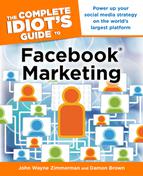Best Practice on Group Pages
Groups tend to be tighter, more formal, and generally more organized than Fan pages. The trade-off is that they involve more work on your part to make sure everything runs smoothly.
A little chaos is totally understandable on a Fan page, as people can come and go as they please. In a group, you have more control, so you’re expected to run a tighter ship. The following sections offer up some general guidelines for keeping your group humming along smoothly.
Connecting Within Groups
Groups are generally smaller than Fan pages, but you still want to make an effort to connect with the individual customers within it.
We recommend gathering a little information about your group members. Facebook gives you a list of all the current people within the group and, depending on their privacy settings, you can glean basic information about each member on his or her Facebook front page. It’s less about snooping and more about noticing a pattern. Your vision of the average customer should start to come together—and it may be different than you previously thought.
To get info on group members, click Members in the left column underneath the Profile picture. Facebook lists all the members. When you click a member’s name, Facebook takes you to that person’s personal page.
You can also simply ask members questions as a way to get to know them. Good questions on the Facebook Wall can create a strong, dynamic, and revealing conversation.
| WATCH OUT |
The hard sell is even more risky on the internet than in the real world. If someone is in your place of business, that means he took the time to come to you, and if he’s turned off by a hard sell, he has to find the energy to leave and seek out another provider. On Facebook, a member can leave your group with two clicks of a mouse.
Don’t push your business too hard to your group. Doing so can block any potential intimacy you have with your customers. Remember that people Like something or join a group because they love the product and/or they believe in what the company is doing. They already joined your group, so you’re at least halfway there. No need for the hard sell. Just treat them with respect.
Remember WIIFM: “What’s In It For Me?”. You can have the best product or service, but you also have to give your customer incentive to work with you. Make sure you give them more than they need.
Sharing Is Caring
Groups thrive on information and discussion. The source of the information matters less than the information itself. This is why you should take advantage of other people’s content.
As an example of what not to do, highly litigious companies like Disney spend millions shutting down homemade projects infringing on their copyrights. Some lawsuits are valid, but most are bullying attempts against people who, at the end of the day, are just really hardcore Disney fans. A five-minute YouTube video of Mickey Mouse made in someone’s basement isn’t going to hurt Disney’s bottom line. The real question is, how big of a Disney fan would you have to be to spend your time and money creating art from its characters?
A wiser decision is to embrace such engagement and creativity from your users, your competition, and even the internet at large. Sharing a funny ad or an art piece can show that it’s not about the sale, but about the discussion and sharing that happens within your community. Use discretion and taste when sharing material, but definitely don’t turn away the bounty of conversation starters coming from outside of your company.
Get Personal
As a rule, groups are more intimate than Facebook Fan pages, and group members expect to get more personalized treatment.
| FEEDBACK |
If you have the resources, consider creating a Facebook Fan page or open Group page for the general public and a hidden Group page for your favored customers. You can use the exclusive group to provide perks to customers—for example, telling them about your sales a week before the Facebook Group gets the announcement. The open Facebook Fan or Group page is more appealing to the more casual customer.
Companies often associate the concept of exclusive treatment with spending money, but that’s not always the case. Here are some free or low-cost ways to make your customers feel special:
• Post extra photos that didn’t make it into the catalog of the latest product.
• Share trivia about your business or products.
• Call out group members and acknowledge them as being loyal customers.
• Fan pages are open, but Group pages are more exclusive.
• There are three types of Group pages: hidden, closed, and open.
• Groups make it easier to contact all the members directly via email rather than through their News Feed.
• Sharing is paramount in groups, even if it is material from competitors or the members themselves.
• Reward your group members with exclusive peeks into your brand.
